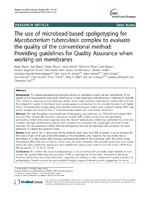Por favor, use este identificador para citar o enlazar este ítem:
http://sgc.anlis.gob.ar/handle/123456789/411| Título : | The use of microbead-based spoligotyping for Mycobacterium tuberculosis complex to evaluate the quality of the conventional method: Providing guidelines for Quality Assurance when working on membranes | Autor : | Abadia, Edgar Zhang, Jian Ritacco, Viviana Kremer, Kristin Ruimy, Raymond Rigouts, Leen Gomes, Harrison Magdinier Elias, Atina Ribeiro Fauville-Dufaux, Maryse Stoffels, Karolien Rasolofo-Razanamparany, Voahangy Garcia de Viedma, Dario Herranz, Marta Al-Hajoj, Sahal Rastogi, Nalin Garzelli, Carlo Tortoli, Enrico Suffys, Philip Noel van Soolingen, Dick Refregier, Guislaine Sola, Christophe |
Palabras clave : | Mycobacterium tuberculosis;Técnicas de Tipificación Bacteriana;Control de Calidad;Tuberculosis;ADN Bacteriano;Genotipo;Reacción en Cadena de la Polimerasa;Humanos | Fecha de publicación : | 2011 | Editorial : | BMC | Journal: | BMC infectious diseases | Resumen : | Background: The classical spoligotyping technique, relying on membrane reverse line-blot hybridization of the spacers of the Mycobacterium tuberculosis CRISPR locus, is used world-wide (598 references in Pubmed on April 8th, 2011). However, until now no inter-laboratory quality control study had been undertaken to validate this technique. We analyzed the quality of membrane-based spoligotyping by comparing it to the recently introduced and highly robust microbead-based spoligotyping. Nine hundred and twenty-seven isolates were analyzed totaling 39,861 data points. Samples were received from 11 international laboratories with a worldwide distribution. Methods: The high-throughput microbead-based Spoligotyping was performed on CTAB and thermolyzate DNA extracted from isolated Mycobacterium tuberculosis complex (MTC) strains coming from the genotyping participating centers. Information regarding how the classical Spoligotyping method was performed by center was available. Genotype discriminatory analyses were carried out by comparing the spoligotypes obtained by both methods. The non parametric U-Mann Whitney homogeneity test and the Spearman rank correlation test were performed to validate the observed results. Results: Seven out of the 11 laboratories (63 %), perfectly typed more than 90% of isolates, 3 scored between 80-90% and a single center was under 80% reaching 51% concordance only. However, this was mainly due to discordance in a single spacer, likely having a non-functional probe on the membrane used. The centers using thermolyzate DNA performed as well as centers using the more extended CTAB extraction procedure. Few centers shared the same problematic spacers and these problematic spacers were scattered over the whole CRISPR locus (Mostly spacers 15, 14, 18, 37, 39, 40). Conclusions: We confirm that classical spoligotyping is a robust method with generally a high reliability in most centers. The applied DNA extraction procedure (CTAB or thermolyzate) did not affect the results in this study. However performance was center-dependent, suggesting that training is a key component in quality assurance of spoligotyping. Overall, no particular spacer yielded a higher degree of deviating results, suggesting that errors. |
Descripción : | Fil: Abadia, Edgar. CNRS Université Paris-Sud 11 Universud. Institute of Genetics and Microbiology UMR8621; Francia. Fil: Zhang, Jian. CNRS Université Paris-Sud 11 Universud. Institute of Genetics and Microbiology UMR8621; Francia. Fil: Ritacco, Viviana. ANLIS Dr.C.G.Malbrán. Instituto Nacional de Enfermedades Infecciosas; Argentina. Fil: Kremer, Kristin. National Institute for Public Health and the Environment; Paises Bajos. Fil: Ruimy, Raymond. Université Paris- Diderot & Microbiology Laboratory; Francia. Fil: Rigouts, Leen. Prince Leopold Institute of Tropical Medicine. Mycobacteriology Unit; Bélgica. Fil: Gomes, Harrison Magdinier. Oswaldo Cruz Institute. Laboratory of Molecular Biology applied to Mycobacteria; Brasil. Fil: Elias, Atina Ribeiro. Oswaldo Cruz Institute. Laboratory of Molecular Biology applied to Mycobacteria; Brasil. Fil: Fauville-Dufaux, Maryse. Scientific Institute of Public Health. National Reference Centre of Tuberculosis and Mycobacteria; Bélgica. Fil: Stoffels, Karolien. Scientific Institute of Public Health. National Reference Centre of Tuberculosis and Mycobacteria; Bélgica. Fil: Rasolofo-Razanamparany, Voahangy. Institut Pasteur de Madagascar. Unité des Mycobactéries; Madagascar. Fil: Garcia de Viedma, Dario. Hospital Gregorio Marañón. Servicio de Microbiología Clínica y Enfermedades Infecciosas; España. Fil: Herranz, Marta. Hospital Gregorio Marañón. Servicio de Microbiología Clínica y Enfermedades Infecciosas; España. Fil: Al-Hajoj, Sahal. King Faisal Specialist Hospital and Research Center. Department of Comparative Medicine; Arabia Saudita. Fil: Rastogi, Nalin. Institut Pasteur de Guadeloupe. Unité de la Tuberculose et des Mycobactéries - WHO Supranational TB Reference Laboratory; Guadalupe. Fil: Garzelli, Carlo. Università di Pisa. Dipartimento di Patologia Sperimentale Biotecnologie Mediche Infettivologia ed Epidemiologia; Italia. Fil: Tortoli, Enrico. Careggi Hospital. Regional Reference Center for Mycobacteria; Italia Fil: Suffys, Philip N. Oswaldo Cruz Institute. Laboratory of Molecular Biology applied to Mycobacteria; Brasil. Fil: van Soolingen, Dick. National Institute for Public Health and the Environment; Paises Bajos. Fil: Refregier, Guislaine. CNRS Université Paris-Sud 11 Universud. Institute of Genetics and Microbiology UMR8621; Francia. Fil: Sola, Christophe. CNRS Université Paris-Sud 11 Universud. Institute of Genetics and Microbiology UMR8621; Francia. |
URI : | http://sgc.anlis.gob.ar/handle/123456789/411 http://www.biomedcentral.com/content/pdf/1471-2334-11-110.pdf |
ISSN : | 1471-2334 | Derechos: | info:eu-repo/semantics/openAccess |
| Aparece en las colecciones: | snrd Publicaciones INEI |
Ficheros en este ítem:
| Fichero | Descripción | Tamaño | Formato | |
|---|---|---|---|---|
| BmcInfectiousDiseases,2011,(11)110..pdf | Artículo en inglés | 366.44 kB | Adobe PDF |  Visualizar/Abrir |
Visualizaciones de página(s)
152
comprobado en 16-dic-2025
Descarga(s)
68
comprobado en 16-dic-2025
Google ScholarTM
Consultar
Los ítems de DSpace están protegidos por copyright, con todos los derechos reservados, a menos que se indique lo contrario.

